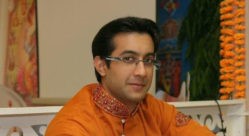From a satsang with Pt. Varistha Persad, Junior Pundit, SWAHA International
BA, MA, PG Dip Ed (UWI), OCT (Intermediate, Senior) DDSB, Durham District School Board, ON (res.) OVS, Ontario Virtual School, ON T III (English), Ministry of Education, TT (res.)
What is the nature of human perception? This question remains relevant when questioning the nature of reality itself. In literary research and studies, there is an area called animal studies where we can read and understand the identity of human beings in relation to other species. In Hinduism, in some of our representations and manifestations of God, the animal is included. In the Shree Raamcharitramaanas, Shree Raam is assisted by the bears and the monkeys; humans then lived in harmony with animals. Also, our seers and sages have related various stories in which animals are featured, which we hear as children in Amar Chitra Katha or the Jataka Tales.
The real question is, how do we perceive animals? If I call someone a monkey, pig or rat, would they be offended? The thought processes and reasons behind calling a human those names are derived from a negative association with animals, and draw on negative animalistic tendencies. We make the mistake of assuming that being, resembling, acting or identifying with the animal is negative. In our childhood days, when we played Ramleela, the simplest role to get is the monkey, and we enjoyed the role; however, as we grow older, we begin to identify negative emotions such as shame with such a role. And yet, in our scriptures and images of the divine, the animal is represented prominently, from the avataars of Vishnu Bhagavan to the divine vaasanas or vehicles.
The term ‘posthuman’ refers to the fact that we are not human, essentially, due to other connections to the self of which we may or may not be aware; we are beyond human. For example, as a result of technology, we are biomechanical: some of us may have a pacemaker or prosthesis, or some other attachment to the body that is not natural. It is perfectly acceptable to incorporate these technological parts in the body as they help keep us alive. Researchers are looking at the possibility that 100 or 200 years from now, the human condition will not be as it is at present given all these technological advancements. Society seems to be moving towards a different type of identity, and we should be aware of that.
Such an awareness is present even in our age-old traditions and scriptures. In the Shree Raamcharitramaanas, Shree Raam lived in a posthuman world where animals, human beings and technology (such as flying chariots) worked together. Furthermore, the concept of avataar (incarnation of God on earth) teaches us that God can assume any form, ranging from man and woman to animal. Everything in creation is a part of us, even the other forms of creation that we refer to as lower forms of life. Shree Raam’s attitude to the bears and monkeys shows how we must change our attitude towards all species in the environment. They are of equal importance and value for the progression of our future world.



